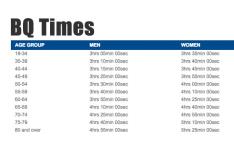
There are probably as many different ways to train for a marathon as there are runners. No?one?training plan is the "right" plan. High-mileage plans work great for some runners while plans with lower mileage that incorporate some speed workouts are better for others. Group training works for many, while others like to run solo.
My philosophy is as long as you're running smart, meaning you're in tune with your body (physically and mentally), then whatever methodology you choose should get you across that finish line. In working with many different types of runners, I have discovered some basic marathon training principles that will help you cross that finish line strong no matter what approach you take.
More: 11 Keys to a Successful Marathon Journey
High Mileage or Quality Run, Not Both
Some plans call for high mileage weeks for most of the training period. Other plans pull back on the weekday mileage and incorporate quality runs (i.e., intervals, hill repeats, tempo runs, etc.). Either approach is valid, but mixing the two can often spell injury for many runners. It's hard for the body to put in high mileage as well as quality workouts week after week. The majority of the runners I've counseled and trained who have been injured during the course of marathon training tried to get the best of both worlds. Pick one method and stick with it.
More: Marathon Speedwork Training That Works
Pull Back and Build
One of the hardest things for established runners to do when starting marathon training is to pull back on their mileage (both total weekly and the long run). If you're already doing 16-mile long runs and logging 40-mile weeks, there's really not much room for you to build and grow.
Your body will love you if you ease off the overall and weekly long run mileage to heal, and then?gradually build endurance, mileage and pace over the course of the training. Increase your weekly mileage by about 10 percent each week, putting most of the increased mileage in your weekly long run, while keeping the weekday mileage about the same each week.
Build Up, Drop Back
A great way to allow your body healing time is to insert some "drop back" weeks into your training. Divide your training into thirds. When you reach the end of the first third of your training, drop back your long run by several miles. For example, if your longest run in the first third is 15 miles, then run 10 miles for your long run in the drop-back week. The week following the drop-back week, run 16 miles for your long run and continue to build until the end of the second third.
By this time, you'll probably have run a 20-miler, so try dropping back to 15 miles for the second drop-back week. The taper (see #10) is the last drop back. This build-up and drop-back approach is not only a great way for your body to recoup, but it's also a great mental break from the hard training. My runners relish the drop-back weeks.
Rest
Some runners think they're being a?whimp?if they take a rest day. Or they think that somehow they're going to lose some ground. Nothing could be further from the truth. One or two rest days during your training week is vital and as important as your run days. If you don't allow the body some days to rest and repair, you'll risk?overtraining?and increase your chance of injury.
- 1
- of
- 2
About the Author

Get ACTIVE on the Go


Couch to 5K®
The best way to get new runners off the couch and across the finish line of their first 5K.
Available for iOS | Android







Discuss This Article